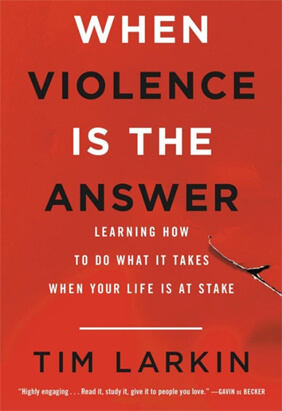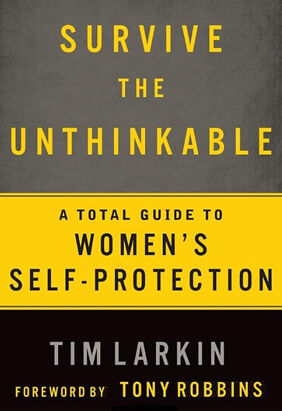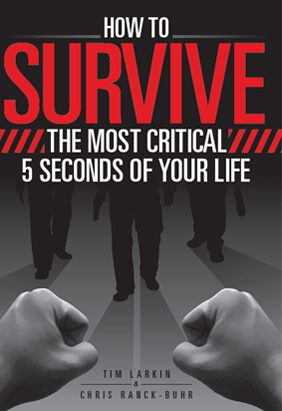
- timlarkin
- antisocial aggression, Asocial Violence, human interaction, interacting with violence, understanding violence
UNDERSTANDING VIOLENCE: FOUR LEVELS OF HUMAN INTERACTION
 When it comes to understanding violence and normal human behavior, there are four general ways in which human beings interact with one another:
When it comes to understanding violence and normal human behavior, there are four general ways in which human beings interact with one another:
As a person – social
This is trying to change behavior, mood, or motivation. This is where most people would like to keep the situation.
As a skill-set — anti-social
This is trying to out-wrestle him, or out-technique him in a 90 mph (144+ kph) chess game. This is a duel in which the most skilled practitioner will typically win. It is “civilized violence” and seen as “fighting fair.”
As an animal (via strength, speed, stamina) — anti-social
This is pitting your strength against his, trying to out-maneuver or out-last him, going blow for blow—this typically looks pretty brutal and ugly. A lot of struggle where the best specimen prevails. This is seen as brutish, desperate and decidedly “uncivilized.”
As a piece of meat — asocial
This is regarding him as a physical object beholden to the natural laws of the universe. Paying no heed to the person, the skill, or the ability. This is seen as almost universally “bad” —people who do this naturally are classified as “evil” in a social setting. This is interfacing with him as a thing that can be broken down and rendered non-functional.
It’s interesting to note that these four levels correspond to different ranges and comfort zones.
Interfacing with the person can be done from across the street, a distance from trouble where most people feel safe (they can always take off running if it gets out of hand).
Interfacing with his skill-set is almost always done at a pace away, with the contestants circling to get a feel for the other guy’s skill level, feinting and parrying and otherwise dancing around. It’s all about giving yourself enough room to see what he’s doing and try to counter it.
Interfacing with his physical abilities is done skin-to-skin, but that’s as deep as it goes.
Interfacing with the frailties of the flesh is done beneath the skin—true injury is about disregarding the sanctity of the body and simply destroying it.
Understanding Violence: What-ifs, Buts and Maybes
The kinds of questions people ask during training can tell you a lot about where their head is at and at which level they’re stuck on with understanding violence. The important thing to note is that none of their worries have any impact on injury whatsoever.
The Socialist
The person who is uncomfortable with the whole idea of conflict will ask questions that dance around the issue from across the street, like, “How can I tell if he wants to hurt me?” and such.
The Duelist
When people trained in martial arts are understanding violence, they usually get hung-up on interfacing with his skill. They’ll ask the most what-ifs, like, “What if he throws a spinning back kick?” “What if he counters my joint lock?” and “What if he’s holding the knife like this?” They are also overly concerned with blocking—both in doing it and worrying about having it done to them.
The Animal
Untrained people who are understanding violence can come to terms with the idea of conflict usually end up fixated on physical attributes. For smaller, less athletic people it manifests as worry about how they’ll fare against bigger, stronger, faster adversaries; big, strong folks have the opposite problem—they typically believe they cannot be defeated by “lesser” beings.
Sociopaths & Butchers
Almost no one shows up comfortable with injury as a starting point.
Another interesting thing to note is that progressing through the levels is not linear. Socialists don’t usually walk through the others to arrive at injury. They go one of two ways—either they dig in their heels and cram their heads into the sand and will never, ever cross the street, or they go straight from where they are to injury (though sometimes with a short stop-over at the animal level).
Duelists are another thing entirely. It is often very difficult to wean them off of the idea that they need to respect and/or thwart his skill before they can be effective. If they do move on, it’s usually with a long stop-over at the animal level. His skill bothered them before; now they’ve transferred that worry to his physical abilities.
Those who have taken the long walk from skill to animal to injury are typically the most evangelical about the whole process.
(As opposed to those who went straight from social to injury. They usually don’t see the whole experience as that big a deal.)
Animals are easier to nudge into interfacing directly with the meat of the matter. They’re pretty close, conceptually, and they just need to be shown how to direct their efforts away from strong points and into the weak ones. (Instead of going strength-to-strength, go strength-to-eyeball.)
If you’re reading this, I’m going to assume that you don’t have a problem with violence in a general sense that you’re not hung up on the social aspects from across the street. So where are your hang ups? What are you stuck on? Are you worried about what he’ll do if he’s skilled? Or bigger-stronger-faster? Be honest with yourself. You’re letting yourself down if you lie–you’re not going to get any more effective that way.
If the idea of going after a trained Goliath makes you sweat (more than the usual, healthy amount, I mean), then you need buckle down on understanding violence and study up on injury. Seek out photos of sports injuries (for broken joints and twisted, non-functioning limbs). Autopsy reports from non-firearm killings—especially where the victim was beaten to death—are illuminating. Troll the internet for videos of prison fights and violent muggings. Essentially, look for anything where the survivor is interacting with the other person as a piece of meat.
You’ll be repulsed and comforted simultaneously.
All Latest Posts
- WHATS MISSING IN ALL SELF PROTECTION TRAINING & WHY THE MEDIA LIKES IT THAT WAY
- SELF-DEFENSE AND FIGHT SCIENCE
- PREVENT VIOLENCE VS. DO VIOLENCE: PART I
- PREVENT VIOLENCE VS. DO VIOLENCE: PART II
- SELF DEFENSE TRAINING: KILLING WITH RULES
- SELF-DEFENSE: STOP FIGHTING AND DELIVER A BEATING
- SELF PROTECTION QUESTION: HOW CAN I JUSTIFY THE USE OF VIOLENCE?
- SELF-PROTECTION MENTALITY: I WAS PREOCCUPIED WITH WHAT I WAS GOING TO DO TO HIM
- FIRST STRIKE: HOW AND WHY YOU SHOULD LAND IT
- INTIMIDATION DURING SELF PROTECTION IS A SUCKER’S GAME
- ANTISOCIAL CONFRONTATION: AGGRESSIVE, BADASS OR DEADLY?
- DEBILITATING INJURY: HOW TO TAKE A PUNCH
- TARGET FOCUS TRAINING PRINCIPLES IN A NUTSHELL
- SELF PROTECTION LESSON: MOVE WITH THE INJURED MAN
- SELF-DEFENSE CLASSES: WHO HAS THE REAL KOOL-AID?
- THE “NUCLEAR OPTION” OF LIFE OR DEATH SELF-DEFENSE
- INJURY IS THE ONLY GOAL OF VIOLENCE
- WHEN IS IT TIME TO LEARN SELF-DEFENSE TECHNIQUE?
- La guía de autodefensa de un teleadicto y otras historias
- Ein Couch-Potato-Leitfaden zur Selbstverteidigung und andere Geschichten
- SELF DEFENSE FACT: FIGHTING IS HARD. HURTING PEOPLE IS EASY.
- THE OL’ ONE-TWO
- ANTI-SOCIAL AGGRESSION AND TRAGEDY ARE AVOIDABLE
- PERSONAL SELF-DEFENSE: THERE ARE NO “EASY” TARGETS
- SELF-DEFENSE LESSONS: YOU CAN’T WAVE AN INVISIBLE GUN
- ARE YOU AGGRESSIVE, BADASS, OR DEADLY?
- THE TARGET FOCUS TRAINING EXPERIENCE
- SELF-DEFENSE Q&A: WHERE DOES TFT FIT INTO LAW ENFORCEMENT?
- IS LETHAL FORCE SELF-DEFENSE USEFUL IN YOUR EVERYDAY LIFE?
- “But I Don’t Want to Kill Anyone!”
- “But What If He Flinches?”
- A Couch Potato’s Guide To Self Defense and Other Stories
- Why Not Just Buy a Gun?
- It’s a Nice Idea–But Does It Really Work?
- There’s only one way to train
- The Beating, the Breaking, or the Fall from a Great Height?
- Speed: The Last Thing You Need For Self-Defense
- Fighting Through Injury
- Targeting: Secret To Self Defense Success?
- Are You Learning To Fight… Or To Dance?
- Generación de máxima potencia
- Maximale Leistung erzeugen
- What Color Crayon Should I Use For A Ruptured Spleen?
- INJURY – The Only Goal Of Violence
- Violence as a Survival Tool
- Generating Maximum Power
- Social Confrontation vs Asocial Violence – Part 3
- Social Confrontation vs Asocial Violence – Part 2
- Social Confrontation vs Asocial Violence – Part 1
- Striking… TFT Style
- The Final Word in Context: MURDER
- Scenario Based Training Vs. The Hard Knot
- Time to Stop Lying to Yourself
- The Mindset to Survive and the Will to Win
- Training to “Wait and See”
- Access the Meat: Choosing the Level of Interaction in Violent Conflict
- Why Self-Defense is NOT Enough…
- SOCIAL OR ASOCIAL VIOLENCE – WHY BOTHER?
- THE ULTIMATE SELF-DEFENSE FIGHTING TECHNIQUE
- STRIKING – TFT STYLE
- ACCESS THE MEAT: CHOOSING THE LEVEL OF INTERACTION IN VIOLENT CONFLICT
- SELF DEFENSE IS NOT ENOUGH
- LEARN SELF DEFENSE: SHUT UP AND HURT HIM
- WINNING VIOLENCE: WOULD IT MATTER TO A SERIAL KILLER?
- DO SELF DEFENSE LESSONS LIKE TFT REALLY WORK?
- SELF-DEFENSE FACT: INJURY IS WHAT WORKS IN VIOLENCE
- SELF-DEFENSE TRUTH: WORRYING ABOUT LOSING WON’T MAKE YOU WIN
- LEARNING SELF-DEFENSE IS NOT ENOUGH
- PROTECT YOURSELF: BUILD A BETTER MONSTER
- LEARN SELF DEFENSE: THE DEFINITION OF VIOLENCE
- SELF DEFENSE QUESTION: ARE THERE ANY DOWNSIDES TO LIVING IN THE CAUSE STATE?
- A SELF DEFENSE TOOL IS JUST A TOOL
- SURVIVING THE AFTERMATH OF SELF-DEFENSE
- MULTIPLE ATTACKERS SELF-DEFENSE: PART THREE
- SELF PROTECTION: NATURE OR NURTURE?
- SELF DEFENSE AND YOUR EXPECTATIONS
- UNDERSTANDING VIOLENCE: FOUR LEVELS OF HUMAN INTERACTION
- WHY DO WE TEACH LETHAL SELF DEFENSE?
- SELF DEFENSE MINDSET: WHAT IS YOUR LIFE WORTH?
- BUT I DON’T WANT TO KILL ANYONE!
- SELF DEFENSE TRAINING VS. MMA TRAINING
- MULTIPLE ATTACKERS SELF DEFENSE: PART TWO
- ES IST EINE MÄNNER WELT… ODER WARUM ICH ES HASSE, FRAUEN ZU TRAINIEREN
- IMPACTANTE ESTUDIO REVELA QUE LA CONDICIÓN FÍSICA NO ES UN FACTOR CUANDO LUCHA POR SU VIDA
- CUANDO TU VIDA ESTÁ EN JUEGO, AQUÍ ES CÓMO JUGAR SEGÚN LAS REGLAS
- SCHOCKIERENDE STUDIE ZEIGT, DASS FITNESS KEIN FAKTOR IST, WENN UM IHR LEBEN KÄMPFT
- WENN IHR LEBEN AUF DEM SPIEL STEHT, SO SPIELEN SIE NACH DEN REGELN
- MANIOBRAS CORPORAL PARA EMPRESARIOS
- KÖRPERMANÖVER FÜR GESCHÄFTSLEUTE
- ES UN MUNDO DE HOMBRES… O POR QUÉ ODIO ENTRENAR MUJERES
- USING VIOLENCE: DEAD MEN TELL NO TALES
- MULTIPLE ATTACKERS SELF DEFENSE: PART ONE
- SLOW YOUR SELF PROTECTION TRAINING DOWN
- SELF DEFENSE TECHNIQUE: BUILD YOUR TARGET MAP
- SELF DEFENSE MOVES: KNOW HOW TO BREAK A NECK
- VIOLENCE & KISS (OR KILL IT SIMPLY, STUPID)
- SELF DEFENSE IS A SHAM • PART 2
- PRACTICING SELF DEFENSE: CAN BIGGER-STRONGER-FASTER MAKE A DIFFERENCE?
- THE BLUEPRINT FOR SUCCESS IN USING VIOLENCE
- SELF DEFENSE IS A SHAM • PART 1
- VIOLENCE STARTS AND ENDS WITH YOU
- FORGET FIGHTING. DELIVER AN INJURY.
- A FIREARM ISN’T EVERYTHING
- NAILING DOWN INTENT
- THE ANATOMY OF A SELF DEFENSE SEMINAR
- THE SELF DEFENSE PARADOX: IF YOU WANT A TRULY PEACEFUL LIFE, THEN TRAIN VIOLENCE.
- WHEN YOUR LIFE IS ON THE LINE, HERE’S HOW YOU PLAY BY THE RULES
- SHOCKING STUDY REVEALS FITNESS NOT A FACTOR WHEN FIGHTING FOR YOUR LIFE
- BODY MANEUVERS FOR BUSINESSMEN
- ITS A MAN’S WORLD… OR WHY I HATE TRAINING WOMEN









